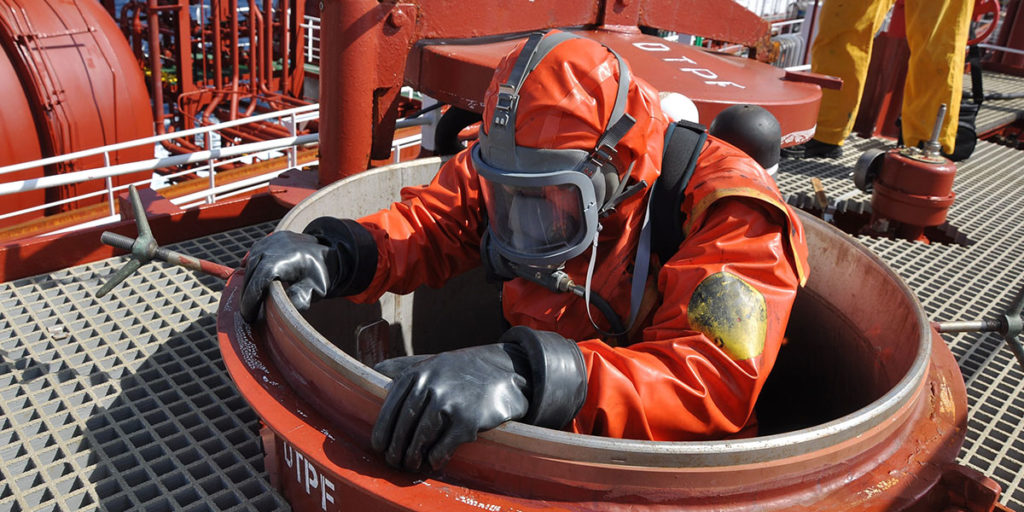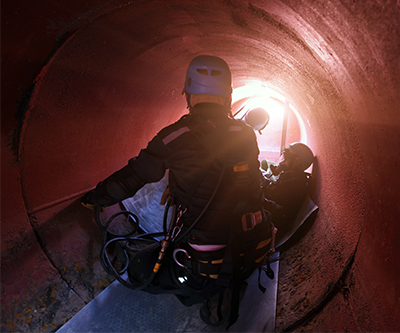Confined Spaces
Posted: Nov. 26, 2019 • By Kevin Kohler

Confined spaces can be lethal
A tragic example of confined space hazards is the Sullivan Mine incident where four people died in a small water sampling hut at a decommissioned mine in Kimberley, B.C. CBC News (Oct 30, 2006) reported on the investigation findings:
“(An) Environmental consultant … was the first victim. He had entered the hut to conduct tests and been overcome. His spouse, after not hearing from him, sounded the alert two days later. (An) employee … was sent to the mine to check …He went into the shed, saw (the) body in the water, assumed he had drowned and called 911 for help before collapsing himself. (Two) Paramedics …, who rushed to the scene, also succumbed to the lack of oxygen when they tried to rescue the two men.”
The hut had almost no oxygen at the lower level sump that was being sampled, but near normal levels at head height.
Are confined spaces still a safety concern today?

Confined space entries are strictly legislated, yet they continue to contribute to fatalities and injuries among workers and rescuers. NIOSH has reported that “More than 60% of confined space fatalities occur among would-be rescuers; therefore, a well-designed and properly executed rescue plan is a must.”
The U.S. Bureau of Labor Statistics reports that there were 166 fatal injuries involving confined spaces in 2017, an increase of 15% over the previous year. We can see that a continued focus on the hazards of confined spaces is well warranted.
What is a confined space?
The definition of a confined space varies from jurisdiction to jurisdiction but some common elements include:
- A partially or totally enclosed space
- Not designed for human occupancy
- Restricted ingress or egress
- Contains (or may contain) an atmospheric hazard such as high or low oxygen concentration, toxic or asphyxiating gases
- Presents a risk to those entering due to the nature of the work being conducted or any other factor
There are specific regulatory requirements to adhere to before entering and working in spaces meeting the local definition of a confined space. Hazards in a confined space are inherently more dangerous than those in a normal work setting. The hazard is often concentrated and it is difficult to provide help.
What requirements are there to enter confined spaces?

Some common requirements include:
- Establishing written procedures, with entry and work in confined spaces by permit only
- Conducting a hazard assessment to determine the appropriate controls to be used
- Logs to record entry and departures from confined spaces
- Controlling all sources of hazardous energy by locking out or otherwise isolating workers from the hazard
- Pre-entry and continuous atmospheric testing by qualified persons in a manner that does not expose them to any hazards
- A rescue plan with qualified first aid/rescuers and equipment readily available
- A qualified safety watch person who has an appropriate means of communication with the confined space workers
- Appropriate PPE for those entering the confined space and qualified tenders for supplied air or ventilation equipment
General and specific training for those entering the confined space and all others with a role in the entry
Best Practices – Be Prepared
We should be prepared for any confined space work by taking an inventory of our workplaces and the work that we normally undertake. Confined spaces should be identified and written procedures should be established in advance if they must be entered from time to time… The hierarchy of controls should be considered and whenever possible confined space work should be eliminated. Preparation and training are key elements in controlling the hazards of confined spaces.
Related Articles

Safety Meetings
Our safety meetings all seem to be the same, I’m not sure of their value We’ve all likely attended a […]
Read Article
Corrective Action Tracking
What is a corrective action? A corrective action is an action taken to eliminate any undesirable or adverse situation (deficiencies). […]
Read Article